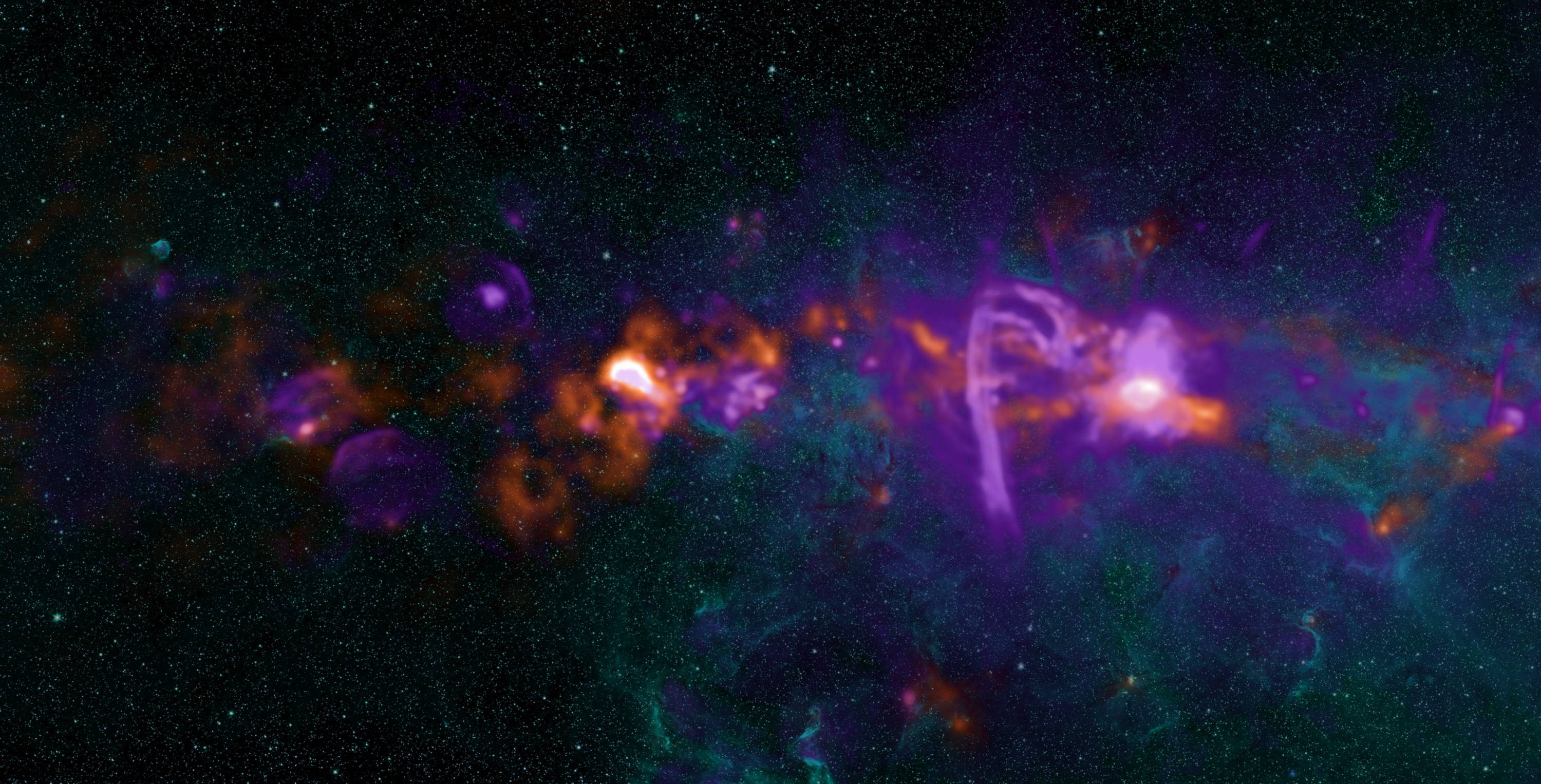Central Molecular Zone on:
[Wikipedia]
[Google]
[Amazon]
 The Central Molecular Zone or CMZ is a region of the
The Central Molecular Zone or CMZ is a region of the
 The Central Molecular Zone or CMZ is a region of the
The Central Molecular Zone or CMZ is a region of the Milky Way Galaxy
The Milky Way or Milky Way Galaxy is the galaxy that includes the Solar System, with the name describing the galaxy's appearance from Earth: a hazy band of light seen in the night sky formed from stars in other arms of the galaxy, which are ...
rich in an estimated 60 million solar mass
The solar mass () is a frequently used unit of mass in astronomy, equal to approximately . It is approximately equal to the mass of the Sun. It is often used to indicate the masses of other stars, as well as stellar clusters, nebulae, galaxie ...
es () of gas within a complex of giant molecular clouds. It spans the centre of the Milky Way, and as such is in the Sagittarius constellation, between galactic
Galactic is an American funk band from New Orleans, Louisiana.
Origins and background
Formed in 1994 as an octet (under the name Galactic Prophylactic) and including singer Chris Lane and guitarist Rob Gowen, the group was soon pared down to a ...
longitude 1.7° and -0.7°, and latitudes -0.2° and +0.2°.
The CMZ differs considerably from other large volumes of the Milky Way in terms of gas density, temperature, and turbulence. Its molecular gas density is several orders of magnitude greater than the galactic disk. Its gas temperature typically ranges from 50 to 100 kelvin but, particularly near the Galactic Center
The Galactic Center is the barycenter of the Milky Way and a corresponding point on the rotational axis of the galaxy. Its central massive object is a supermassive black hole of about 4 million solar masses, which is called Sagittarius A*, a ...
, can be as high as 400 to 600 K. Sampling of spectral line widths within the CMZ are in the 15 to 50 km/s range, compared to 1 to 10 km/s for giant molecular clouds in the galactic disk. Additionally, compared to the galactic disk, the CMZ produces a higher flux of cosmic rays and also emits copious ultraviolet and X-ray radiation.
The CMZ is asymmetrical with a diameter varying from approximately 1600 to 1900 light-years. Its highest gas surface densities are found east of the Milky Way's dynamical center at positive latitudes and velocities. Estimates of CMZ mass distribution indicate it has three times more mass present in its positive galactic latitudes compared to its negative latitudes. Additional to its internal asymmetry, the CMZ's orbital plane may be tilted approximately 5° with respect to the galactic plane at large.
The CMZ contains the Galactic Center Radio Arc, various supernova remnants
A supernova remnant (SNR) is the structure resulting from the explosion of a star in a supernova. The supernova remnant is bounded by an expanding shock wave, and consists of ejected material expanding from the explosion, and the interstellar mat ...
, and emission nebula
An emission nebula is a nebula formed of ionized gases that emit light of various wavelengths. The most common source of ionization is high-energy ultraviolet photons emitted from a nearby hot star. Among the several different types of emission n ...
e. Regions with concentrations of gas are titled Sgr D HII, Sgr D SNR, SNR 0.9+0.1, Sgr B1, Sgr B2, SNR 0.3+0.0, Sgr A, SNR 359.1-00.5, SNR 359.0-00.9, Sgr C, Sgr E and also thread-like features called the Mouse, Snake, and Cane. Molecules found in the zone include carbon monoxide
Carbon monoxide (chemical formula CO) is a poisonous, flammable gas that is colorless, odorless, tasteless, and slightly less dense than air. Carbon monoxide consists of one carbon atom and one oxygen atom connected by a triple bond. It is the si ...
, methanol
Methanol (also called methyl alcohol and wood spirit, amongst other names) is an organic chemical compound and the simplest aliphatic Alcohol (chemistry), alcohol, with the chemical formula (a methyl group linked to a hydroxyl group, often ab ...
, isocyanic acid
Isocyanic acid is a chemical compound with the structural formula HNCO, which is often written as . It is a colourless, volatile and poisonous gas, condensing at 23.5 °C. It is the predominant tautomer and an isomer of cyanic acid ''( ...
, hydrogen cyanide
Hydrogen cyanide (formerly known as prussic acid) is a chemical compound with the chemical formula, formula HCN and structural formula . It is a highly toxic and flammable liquid that boiling, boils slightly above room temperature, at . HCN is ...
and silicon monoxide
Silicon monoxide is the chemical compound with the formula SiO where silicon is present in the oxidation state +2. In the vapour phase, it is a diatomic molecule.
It has been detected in stellar objects and has been described as the most common o ...
. Concentrations of cold dust with diameters of approximately 0.1 to 0.65 light-years, which are likely progenitor cores of future star systems, number in at least the hundreds.{{cite journal , last1=Hatchfield , first1=H Perry , display-authors=etal , title=CMZoom. II. Catalog of Compact Submillimeter Dust Continuum Sources in the Milky Way's Central Molecular Zone , journal=The Astrophysical Journal Supplement Series , doi=10.3847/1538-4365/abb610 , date=November 2020, volume=251 , issue=1 , page=14 , arxiv=2009.05052 , bibcode=2020ApJS..251...14H , s2cid=221640775 , doi-access=free
References